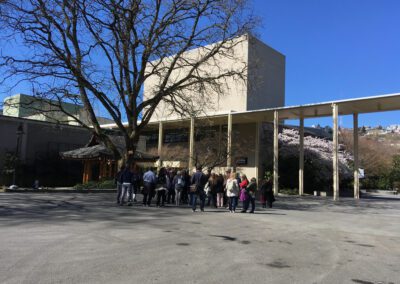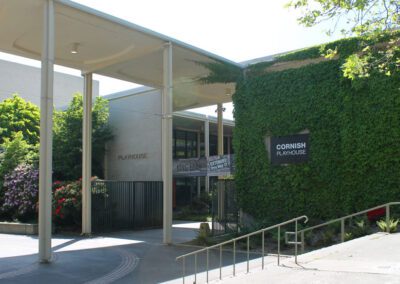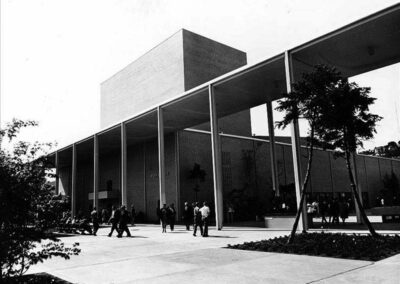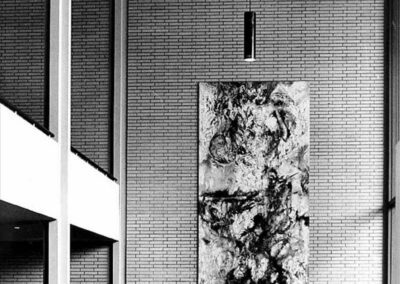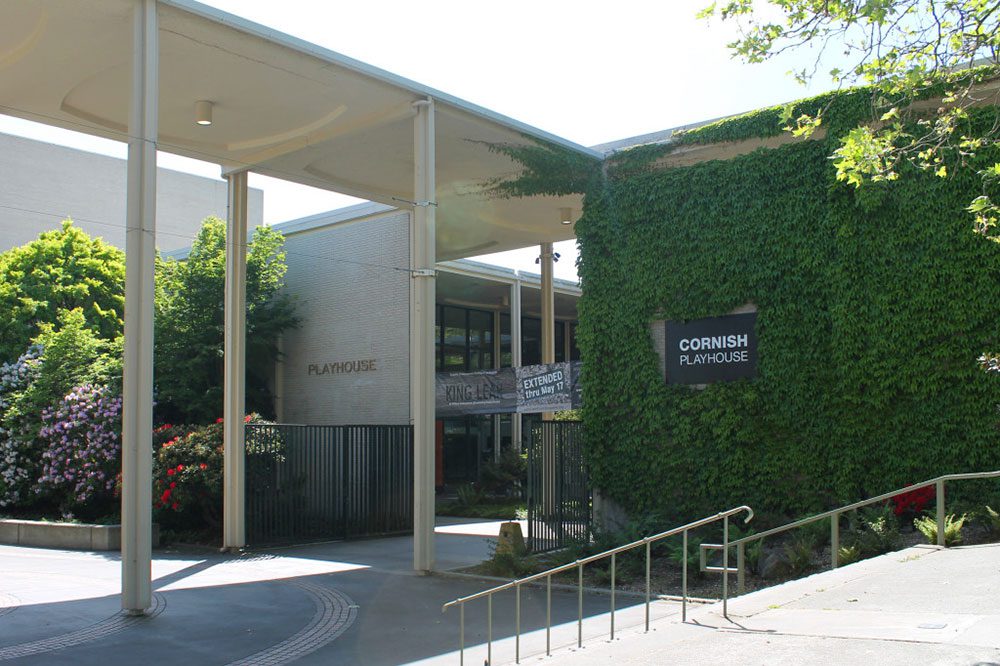
Seattle Center Playhouse and Exhibition Hall
201 Mercer Street (Playhouse); 301 Mercer Street (Exhibition Hall), Seattle, WA 98119
Built 1961
The content below is from a 2023 Seattle Landmarks Nomination Form.
The History
The present-day Phelps Center and Cornish Playhouse exist within the Seattle Center site—where the Century 21 Exposition (1962 Seattle World’s Fair) was held in 1962 and where the Civic Center had stood prior to the world’s fair. The area has been a public gathering place for over a century for Seattleites and visitors to the city. The Phelps Center and Cornish Playhouse were constructed for the world’s fair as the Exhibition Hall (Fine Arts Pavilion) and Playhouse, respectively, within the Multi-Purpose Auditorium Group. They were intended for long-term use by the city after the fair was over.
Once World War II ended, Seattle’s population continued to grow, and time for leisure began to increase. After years of civic boosters building support, Seattle Mayor Allen Pomeroy established a new committee, the Civic Center Advisory Committee, to pursue the creation of a civic center that would meet the city’s cultural, art, music, theater, and community needs. As the city sought to create a civic center, city boosters began considering and promoting the idea of Seattle hosting another world’s fair, hoping to recapture the success of the 1909 Alaska-Yukon-Pacific Exposition.
Proposals for a concert and convention hall and multi-purpose auditorium were included in early discussions regarding development of the civic center site, even before the site was selected for the 1962 world’s fair. A June 1956 report by the Civic Center Advisory Committee unanimously agreed on constructing a new auditorium complex to help complete the proposed civic center site.6 Once funding was approved by Seattle voters, design work commenced on the various construction projects at the civic center site, including the multi-purpose auditorium group. Seattle City Council hired Paul Hayden Kirk and Marcus B. Priteca to plan the complex. Their design for the 800-seat auditorium and 40,000-square-feet of covered convention, meeting, and exhibit space was due for review by August 1, 1960. Public input was sought before and during the design phase as the complex was intended as a permanent addition for the civic center site. John Spaeth—Director of Planning for the City Planning Commission and chairman of the Civic Center Advisory Commission— stated, “We intend to have the design worked out for the maximum use of citizens of Seattle in the future as well as Century 21.
The Exhibition Hall, called the Fine Arts Pavilion or Fine Arts Exhibit by the Fair, was designed to house three monumental exhibitions of fine art for Century 21, which Dingwall asserted would be “the No. 1 prestige factor of the exposition in America and abroad.” Norman Davis, the director of the fine arts division at the World’s Fair, organized the displays, selecting curators and coordinating with experts.
The Playhouse was built as one of two “highbrow” performance venues for the fair, the other being the Opera House. The 800-seat Playhouse was a much more intimate venue in comparison to the 3,100-seat Opera House. Harold Shaw, performing-arts director, oversaw the bookings for all events at the fair’s Opera House, Playhouse, Arena, and Memorial Stadium. In spring of 1961, Shaw spent two months traveling Europe scouting talent for the 1962 world’s fair. He made additional trips around the world, ultimately traveling to 47 different countries, to scout talent and negotiate bookings. Shaw’s efforts, alongside other members of the Performing Arts Division, created an impressive lineup for the fair’s Opera House and the Playhouse in particular. The Playhouse featured cultural performances, like the Ceylon National Dancers, dance troupes, and musicians. The lineup of performances at the Playhouse, according to the fair’s program brochure, included matinee and evening performances. In addition to the performances held in its theater, the Playhouse showcased at least two additional art pieces: James FitzGerald’s Fountain of the Northwest in its courtyard and Kenneth Callahan’s painting (unnamed).
Although theater has long been part of Seattle’s history in various forms, there was no theater company permanently based in Seattle at the time the World’s Fair occurred in 1962. After the fair ended, Seattle businessman and theater patron Bagley Wright gathered other theater patrons to establish Seattle’s first consistent theater company— the Seattle Repertory Theatre (or The Rep or Seattle Rep). After its founding in 1963, the Seattle Rep moved into the Playhouse at Seattle Center and, according to The New York Times, became “this city’s flagship theatre.” After the Seattle Rep left the Playhouse, that building did not have a permanent tenant until it was remodeled in 1986, after the City of Seattle granted an extended lease to the Intiman Theatre.
The 1986 renovation of the Playhouse was the first significant renovation of the building since it was constructed. The $1.2 million renovation to the interior was described in The Seattle Times by drama critic Wayne Johnson, who stated, “The only parts of the old Playhouse still visible are an overhead catwalk and portions of the two side walls.” In 2013, Cornish School for the Arts began leasing the Playhouse, calling it Cornish Playhouse. In 2020, Intiman moved to a new home on Capitol Hill and established itself as the professional theatre-in-residence at Seattle Central College—leaving Cornish as the sole tenant of the Playhouse. James FitzGerald’s Fountain of the Northwest remains an integral part of the Playhouse’s courtyard (branded Ewen C. Dingwall Courtyard in honor of the fair’s first employee and director). An additional art piece has been installed in the courtyard since the fair ended: James W. Washington, Jr.’s Barbet. In 2000 Gerard Tsutakawa’s Seseragi fountain was added on the south side of the Playhouse, facing the International Fountain.
After the fair ended, the Fine Arts Pavilion became known as Exhibition Hall at Seattle Center. The space became available for use as a convention facility, as well as a display, event, and banquet hall. Shows at the hall included auto shows, art shows, award ceremonies, and public auctions. The first event held in the newly branded Exhibition Hall after the fair was the Seattle Auto Show in January 1963. Early improvements to Exhibition Hall included the completion of a public-address system and the installation of acoustical materials. The city signed a five-year lease with Century 21 Center, Inc., a non-profit corporation, to run Seattle Center; however, the city operated the Coliseum, Playhouse, Exhibition Hall, Opera House, and Arena. By the end of 1964, the city proposed to take over full control of the site’s operation.
The Exhibition Hall continued to host a variety of events for nearly three decades. In 1974, the Guardian Lions statues (artist unknown) were added outside the entrance to the Exhibition Hall. The Pacific Northwest Ballet (PNB) has performed at Seattle Center since the very beginning, The Exhibition Hall remains as the studio and office space for the PNB, while performances occur next door at McCaw Hall.
The Building and Site
Both the Playhouse and Exhibition Hall were designed in the New Formalist architectural style. This style emerged in the 1950s and became popular during the 1960s. Edward Durrell Stone’s design of the New Delhi American Embassy (1954) is often considered the beginning of the New Formalist style. It harkened back to Classical precedents—such as scale and proportion, symmetry, and the use of columns and colonnades—while utilizing modern materials and new building technology and forms. New forms employed on New Formalist buildings included umbrella shells, waffle slabs, and folded plates. Civic New Formalist buildings often had a grand scale and might be elevated on a raised podium. Rich, traditional materials such as granite and travertine (or man-made materials to mimic them) were typically utilized as well as brick and cast stone. The structure on New Formalist buildings was often highlighted, particularly on the exterior and frequently on the interior. The colonnades running along the north and south facades of the Playhouse and Fine Arts Pavilion are clear hallmarks of New Formalism. The folded plate roof of the Fine Arts Pavilion, along with the smooth appearing wall surfaces of both buildings, are also elements of the style. The interior structures of both buildings are prominent in the Playhouse’s lobby and upper level of the Fine Arts Pavilion.
Courtyard grade corresponds to the building’s first story and functions as part of the front entrance sequence. The original courtyard design consisted of a central, square fountain basin with inner and outer rectangular-plan walkways separated by rectangular planting beds. Access between the outer to inner walkways consisted of a 20-foot-wide north walkway centered on a column, a 20-foot-wide east walkway set between two columns, and two 10-foot-wide walkways on the south side.
Brick clad concrete walls set between concrete columns enclose the courtyard. A flat roof extends above only the perimeter walkway within the courtyard, leaving the central portion open. Narrow openings occur between the walls and roof at the outer northeast and northwest corners. Within the courtyard volume, a double-entry concrete stairway descends from the gated west entrance. The east, gated entrance enters at grade level from the colonnade. The glass wall of the building’s north facade defines the south edge of the courtyard. The four-part abstract cast bronze Fountain of the Northwest (1961), designed by artist James FitzGerald occupies a shallow square concrete basin within the middle of the courtyard. A circular brick paver walkway from 1986 radiates out from the fountain. Altered connecting pathways on the north and south sides of the circular walkway link to the courtyard’s perimeter walkway. Concrete benches enclose the east and west sides of the circular walkway, with planting beds behind, and infilling the former east pathway to the fountain. Added gates at the east and west entrances are tall painted metal.
Original cast stone benches along this walkway sit at the southwest corner of the courtyard and at the south end of the east wall. Each utilizes a white aggregate, with two square pedestal legs, a seat having a curved underside, and a space separation between the legs and seat. A bronze plaque on the courtyard’s east wall commemorates the 1989 courtyard dedication to World’s Fair vice president/general manager and long-time Seattle Center director, Ewen C. “Ding” Dingwall “in appreciation for his vision and enthusiasm for Seattle Center from 1957 to 1988.” The carved river rock sculpture Barbet (1964) by artist James W. Washington Jr. is at the south end of the east planting bed.
A reinforced concrete, grade beam perimeter foundation supports the exterior walls with concrete spread footings carrying the internal structure. A reinforced concrete column structure supports the three-story (30 foot tall) building and eight-story (79 foot tall) fly loft. Running bond brick panels with offset brick headers infill between the columns. Bricks are cream to light tan in color. The slender columns consist of a central square post with projecting square sided fins forming an overall cross shaped plan. The fins have a 6 inch face with a 5 inch projection. The bottom ends of the fins are raised 4 inches above grade with only the center post connecting to the foundation. Originally, pierced brick openings occurred at the south end of the east facade. Alterations in 1997 installed the exterior steel planting grid attached to the south end of the east facade.
The main building has a flat concrete roof deck with a low perimeter parapet. The north portion of the roof soffit above the lobby consists of recessed panels with elliptical arched edges and a central round can downlight matching the colonnade roofs. A square cornice at the base of the parapet projects slightly, the width of the outer column fin. The low-pitched side gable roof over the seating area rises 9 feet above the main building roof and has flush gable ends and eaves with a low perimeter parapet. The roof consists of cast-in-place concrete beams and roof deck. The roof over the fly loft is flat with a low perimeter parapet. Steel girders span the volume, with smaller steel beams carrying the steel roof decking. All parapets have sheet metal coping. All roofs are clad with rolled composition roofing.
Windows occur only on the west and south facades. The windows are insulating glazing set in aluminum frames. The windows have narrow hoppers and awning sashes for ventilation. Glass and steel projecting sunscreens extend out above each window group with diagonal steel bracing connecting to the concrete columns. The south facade originally did not have windows. Added window openings occurred at the second story dressing rooms in 1997 and third story office spaces dating from 1986. All windows are black, anodized aluminum frames. The second story windows are 1:1 with a lower awning sash. The third story windows have fixed transoms and sash, and small lower hopper sashes. Opening headers extend to the roof line.
The north entrance is the main public entrance for the building and functions in connection with the courtyard. The floor to ceiling glass and steel curtain wall consists of fixed lights with insulating glass set in the original painted steel frames. The curtain wall enables visual connection between the building interior and the courtyard. The six bays of glazing are set within the building’s slender concrete columns. Steel transom bars divide each bay into three parts. The upper transom bars were added in 2006. Two original doorways with replacement tall flush-panel wood doors provide access to the interior. Exterior recessed walk-off mats occur at each entrance. Fixed glazing infills the other two original entrance locations and central ticket booth location. Added drink rail counters project on the interior from the steel frames.
The first floor consists of a three-story lobby volume that extends from the north end south along both sides of the performance volume. A balcony at the second story extends out into the three-story lobby volume at the north end and sides. The slender concrete columns and decorative recessed concrete ceiling panels, characteristic of the colonnade and courtyard, extend into the first two bays at the north end of the lobby volume. Flat plaster ceilings continue to the south. In 1997, cladding that was added in 1997 enclosed the central three columns supporting the balcony. A Kenneth Callahan painting hangs in its original location at the northwest corner with a William Ivey painting installed in 1997 at the northeast corner, at the south end of the east lobby, and at the south end of the west lobby.
The lobby finishes consist of replacement wall-to-wall carpeting with brick veneer walls. A concessions area and counter are set below and south of the balcony and are flanked by uncased doorways to the universal access restrooms and the basement restrooms. Added framing and wall panels, illuminated by added directional lighting, provide locations for temporary artwork along the walls at the two sides of the lobby. Pendant lighting fixtures, uplighting at the top of the added column enclosures, and recessed can lighting along the underside of the balcony provide lighting.
The performance volume occupies the middle portion of the building and was reconfigured in 1986 from a proscenium to a thrust stage, with tiered seats arranged on three sides of the central projecting stage. The change also reduced the auditorium seating capacity from 800 to 434. Aisles composed of wood stairs extend along the outer sides and central portions of the seating area. Two control booths exist at the north end of the auditorium. The angular original booth with glass windows and projector openings remains above the suspended ceiling, with the lower booth containing the electronic control systems supporting performances. An added maintenance room extends east of the lower booth and provides access to the catwalks.
Two sets of catwalks extend above the auditorium, the upper original and a lower set installed in 1981. These provide access to the house lights, including the original metal box containing the stage lights, an original annunciator. Both catwalks consist of painted metal framing suspended from the ceiling, with carpeting at the new and metal at the original walkways. The thrust stage has a wood floor with the reinforced concrete fly loft walls enclosing the stage house behind the proscenium. A metal gridiron above the stage supports act and fire curtains for closing the proscenium opening, lighting, and associated flat curtains to mask the lighting. Ropes and counterweights for raising and lowering elements in the fly loft occupy the wall east of the stage, with a counterweight platform and guides supporting the counterweight arbors painted the distinct colors of the rainbow. The colors from north to south are red, light blue, yellow, green, orange, and dark blue. They repeat in the same sequence. The original metal counter weights, stamped with “City of Seattle,” remain in use.
The prop room for use by staff to create setwork for performance, is west of the stage. A two-story corrugated metal-clad top-hung door, made by the St. Louis Fire Door company, opens between the room and the stage house. A metal spiral stairway provides access to the second floor level of the prop room. Finishes consist of wood flooring, with plywood and concrete walls and metal ceiling decking. The double-loaded hallway running east to west provides circulation between the two back-of-house stairways, stagehouse doorways (north side), and staff restrooms and storage spaces (south side). Finishes consist of painted concrete flooring, painted concrete block walls, and unpainted concrete beam ceiling. Storage rooms and restrooms have the same finishes; the piano original to the building is in one storage room, on wheels so it can be rolled out as needed for performances.
The green room, for use by performers when not on stage, is east of the performance volume with a flush-panel metal door exiting to the north lobby. The two-story volume has brick and painted gypsum board finishes, concrete flooring, and painted plaster ceiling, with seating for performers. Troffer type fluorescent tube lighting fixtures hang on an added metal frame.
The second floor consists of a front-of-house lobby and concession area with access to the auditorium seating, as well as a back-of-house area for staff and performers. The lobby functions as an extension of the first floor lobby, with a central concession and lounge area, and continuing the same finishes. The wings on either side extending along the auditorium sides were added in 1976. Railings along the north edge were replaced and reconfigured in 1997. The double-loaded hallway running east to west provides circulation between the two back-of-house stairways, the dressing rooms (south side), and staff workspaces (north side, east end). Finishes consist of painted concrete flooring, painted concrete block walls, and painted concrete beam ceiling. The two dressing rooms each consist of open volumes with exposed, painted concrete beam ceilings. Flooring consists of vinyl tiles with painted concrete block walls and glazed concrete block at each room’s restroom and shower. Some of the dressing rooms contain the original wood stations with Formica counters and single-bulb fixtures in metal cages around three large mirrors. The added west station in room A is similar but has different metal cages at the light fixtures.
The third floor consists of a back-of-house area for staff and has a U-shaped plan that wraps around the west, south, and east sides of the fly loft. A double-loaded hallway runs east to west, providing circulation. Finishes consist of carpeting with painted concrete walls and a concrete beam ceiling. A main open volume office space with vinyl tile flooring extends along the middle portion of the south facade, with a smaller office at the west end and a work area at the east end. Alterations in 1986 removed former dressing rooms to create the open volume and glued acoustical tile to the concrete ceiling. A carpeted staff work area and restroom with vinyl tile flooring are north of the hallway along the east side of the floor, with offices and a reception area along the west side of the floor. Interior finishes consist of painted concrete and concrete block walls and concrete beam ceilings. Lighting throughout the spaces consists of troffer type, pendant types with metal reflectors, and can downlighting fixtures.
The Architects, Kirk, Wallace, McKinley & Associates
The Playhouse and Fine Arts Pavilion were designed by renowned local architectural firm, Kirk, Wallace, McKinley & Associates. This firm succeeded Paul Hayden Kirk, FAIA, when Kirk promoted his associates Don S. Wallace and David A. McKinley, Jr., to full partnership.
Born in Salt Lake City in 1914, Paul Hayden Kirk and his family moved to Seattle in 1922. Kirk spent his childhood in Seattle and continued to live in the city during college, attending the University of Washington and studying architecture. As his career progressed, Kirk’s work increasingly showcased intricate details and natural materials. He expanded his office as his workload increased, renaming the firm in 1957 to Paul Hayden Kirk & Associates. The firm was renamed again in 1960 (Kirk, Wallace, McKinley & Associates) when Kirk promoted Don S. Wallace and David A. McKinley, Jr., to partners. Kirk continued to work until his retirement in 1979 when he retired.
Born in Spokane in 1915, Donald Sheridan Wallace first attended Eastern Washington College of Education in 1934. He did not graduate, but later attended the University of Washington and received his degree in architecture in 1952. He worked with Harold A. Hovind & Associates while still a student and continued after graduation until 1954. He then began to work for Paul Hayden Kirk becoming an associate in 1958 and then a partner in 1960. Wallace spent the remainder of his career with the firm, including its transition after Kirk’s retirement to The McKinley Architects.
David Alexander McKinley, Jr., was born in Spokane in 1930. He moved to Seattle for college and attended the University of Washington. He graduated in 1953 with a degree in architecture and soon began to work for Paul Hayden Kirk. He advanced in the firm to associate and then partner. After Kirk’s retirement, the firm was reorganized as The McKinley Architects, reflecting McKinley’s leadership in the firm. He remained with the firm for his entire career until his retirement. Designs by the firm under McKinley’s leadership and name include KING Broadcasting Company (1979–81), the Alaska Airlines Headquarters (1978–80), One Bellevue Center (1981–83) in Bellevue, First Interstate Center (now Wells Fargo Center, 1981–84), the Nordstrom Tennis Center at the University of Washington (1985–87), the 1201 Third Avenue Building (formerly Washington Mutual Tower, 1984–90), and the Seattle Children’s Theater (1990–93).
Jerry Robert Geyer was born in Hinsdale, Illinois, in 1927. Although his studies were interrupted by the Korean War, he then returned to school, graduating in 1954 from the Illinois Institute of Architecture and moving to Seattle the same year. By 1958, Geyer was employed as an architect by Paul Hayden Kirk & Associates. Geyer was a member of the American Institute of Architects and a board member of the Northlake Unitarian Fellowship. His life and career were cut short when he suffered a heart attack and died in 1964, at the age of 36.
Seattle Center Playhouse | Seattle
Built 1961 | Source: University of Washington Special Collections SEA0429
